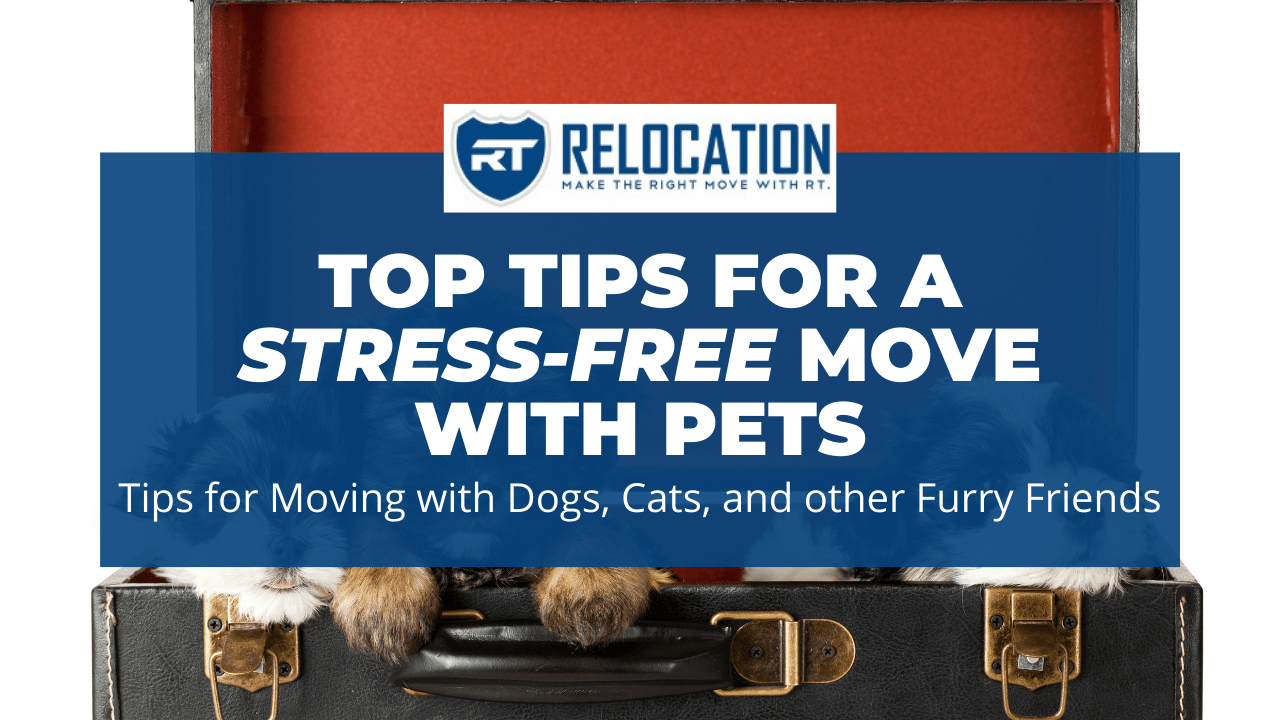Top Tips for Moving With Pets
Table of Contents

Moving is stressful for people, but can be even more stressful for pets. During a move, they have no idea why their whole life is being turned upside down. Taking the right steps can help both you and your pets get through a move with ease. Here are a few tips to help you move with pets.
Top Moving Tips for Owners with Pets
Plan Ahead
Whether you’re moving with dogs and cats or moving with reptiles and birds, preparation is key to a successful move. The sooner you get started preparing, the better.
Know the State Laws Around Moving with Pets
Many states have laws about moving with pets. Some states have laws about the amount of time an animal is kenneled and many states may require documentation like health certificates or licensing upon entry. In some cases, certain dog breeds and reptiles are banned or restricted in certain communities and you may need to muzzle, leash, or have proof of insurance for your pet(s). You can contact Animal Control in the city you are moving to for more information. In any case, it is best to find out the requirements and/or restrictions sooner than later.
Check-In With Your Vet
Since this is a stressful time for your pets, a general checkup is important. Also, you should make sure that they are up-to-date on their vaccinations and regardless of where you travel, you should keep their tags and documentation with you at all times. Let your veterinarian know that you will be moving and together you can decide if your pet should be medicated before, during or after the move. There are also alternative options, such as thunder shirts or natural remedies to help reduce their anxiety.
Prepare Your New Home
If the previous owners had pets, it is a good idea to have your new home deep-cleaned, prior to your arrival. This will help eliminate any smells that could stress your pet(s) out when they enter their new home.
On Moving Day
Keeping your pets away from the action on moving day is key to a successful move. You may want to consider leaving them with a friend or family member or putting them in a kennel until it’s time to go. If this can’t be done it is extremely important to keep the pet in a quiet room that won’t be disturbed. Be sure they have ample food and water and their bed or toys to keep them comfortable and calm. It is always important to know where they are at all times and to notify the movers of their location. Pets can easily escape, get lost or get stressed from all of the commotion.
Transporting Your Pet by Car
Before you go, be sure you have everything you need for your pets. Here’s a checklist to ensure you have what you need:
- Leashes and Documentation
- Your Vet’s Phone Number
- Food, Treats, Water and Dishes
- Comfort Items, Such as Blankets and Toys
- Towels, Paper Towels and Wipes
- Waste Bags
- First Aid Kit
If you are driving to your new home, the car is the obvious choice to transport your pet(s). Most dogs and some cats actually love to go on car rides, but there are a few things to consider, especially if you are moving out of state. If you have a long journey, be sure to map out pet friendly stops, such as hotels, campgrounds, dog parks and restaurants along the way. Not sure how? You can visit GoPetFriendly.com for more information.
The actual ride also needs careful consideration. It is important to make sure your pets are secured during your trip. Using a crate, carrier or car harness will make sure that your pets are safe and will ensure that they don’t distract you while you’re driving. Sometimes, animals feel more comfortable if you put a blanket over their carrier, so that they do not get stressed by the activity outside. Also, if your vehicle is equipped with airbags, be sure to deactivate the airbags for the seat(s) your pet(s) will be occupying. Last, when you stop, it’s a good idea to attach their leash before opening the door, to make sure they don’t escape!
Transporting Your Pet by Air
A lot of airlines allow pets to fly. In many cases, if your pet is small enough, they can fly in the cabin with you in an airline-approved carrier. Some airlines are more pet-friendly than others, so do your research up front to determine the best airline for you and your pets.
If you have larger animals or exotic pets, like; birds, hamsters, gerbils, guinea pigs, chinchillas, rats, mice, rabbits, ferrets, or reptiles (snakes, lizards, turtles, tortoises, etc.), they will more than likely have to fly in the baggage compartment. Additionally, they will have strict guidelines and instructions, so it is best to do your research in advance. Last, you should know that the airline will not move your pets if there are extreme temperatures (hot or cold), so be sure to plan your move accordingly.
Using a Pet Transportation Company
If you are unable to transport your pet during your move, you may want to consider using a pet transportation company. These companies can pick up your pet up at home and deliver them to your destination. Be sure to use a reputable company and work closely with them to ensure you have everything in place prior to the move so that your pet(s) don’t get left behind on moving day.
PET SPECIFIC MOVING TIPS
Moving with Fish
Fish can get easily stressed and moving them can be traumatizing and often fatal. If you are moving a short distance, you can move them in a bag filled with their tank water. If, however, you are moving a long distance, it’s better to rehome your fish and buy new ones once you are settled into your new home.
Moving with Guinea Pigs, Gerbils or Hamsters
Like most other pets, these animals can not only suffer mentally from a move, but physically as well. It is important that they are transported carefully in a small, warm and comfortable cage. This will ensure they feel safe and help them to not get jostled around during the move.
Moving with Birds
Whether you have a Cockatoo, Parrot or Parakeets, it is imperative to keep your bird(s) safely in a cage on moving day and while transporting them. Even the best trained birds have been known to fly the coop during times of stress. The last thing you will want to do on moving day is search for your missing bird(s).
Upon Arrival
Once you and your pet(s) arrive at your new location, there will be an adjustment period for both of you. Encourage your pet(s) to explore their new surroundings. Placing familiar items, such as their bed, toys and treats around the home will help them settle in more easily. It’s also important to be extra vigilant to ensure they don’t escape. Once you are settled, be sure to find a new vet and update their tags and microchip with your new address and phone number.
Moving with pets is stressful for everyone, but with proper planning and consideration, the stress can be minimized. If you know you are going to move, request a quote today and let us help you plan your move.









